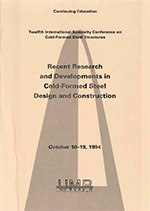Location
Saint Louis, Missouri
Session Dates
18 Oct 1994
Abstract
This paper describes a test programme conducted into the behaviour of cold-formed, compact square hollow section beam columns. The tests were conducted in a purpose built test rig capable of applying load and moment in a constant ratio. The test specimens were pin-ended specimens loaded, with varying load/moment ratios, at two different ratios of end moment. The results of the tests were simulated using a finite element programme. This finite element programme was used to find maximum second order elastic moments, for the section tested, at varying ratios of end moment. The results of this numerical investigation are compared with the relevent interaction design rules from AS4100 (Standards Australia (1990)) and the AISC-LRFD specification (1986).
Department(s)
Civil, Architectural and Environmental Engineering
Research Center/Lab(s)
Wei-Wen Yu Center for Cold-Formed Steel Structures
Meeting Name
12th International Specialty Conference on Cold-Formed Steel Structures
Publisher
University of Missouri--Rolla
Document Version
Final Version
Rights
© 1994 University of Missouri--Rolla, All rights reserved.
Document Type
Article - Conference proceedings
File Type
text
Language
English
Recommended Citation
Sully, Raef M. and Hancock, Gregory J., "Behaviour of Cold-formed SHS Beam-columns" (1994). CCFSS Proceedings of International Specialty Conference on Cold-Formed Steel Structures (1971 - 2018). 1.
https://scholarsmine.mst.edu/isccss/12iccfss/12iccfss-session5/1
Behaviour of Cold-formed SHS Beam-columns
Saint Louis, Missouri
This paper describes a test programme conducted into the behaviour of cold-formed, compact square hollow section beam columns. The tests were conducted in a purpose built test rig capable of applying load and moment in a constant ratio. The test specimens were pin-ended specimens loaded, with varying load/moment ratios, at two different ratios of end moment. The results of the tests were simulated using a finite element programme. This finite element programme was used to find maximum second order elastic moments, for the section tested, at varying ratios of end moment. The results of this numerical investigation are compared with the relevent interaction design rules from AS4100 (Standards Australia (1990)) and the AISC-LRFD specification (1986).



